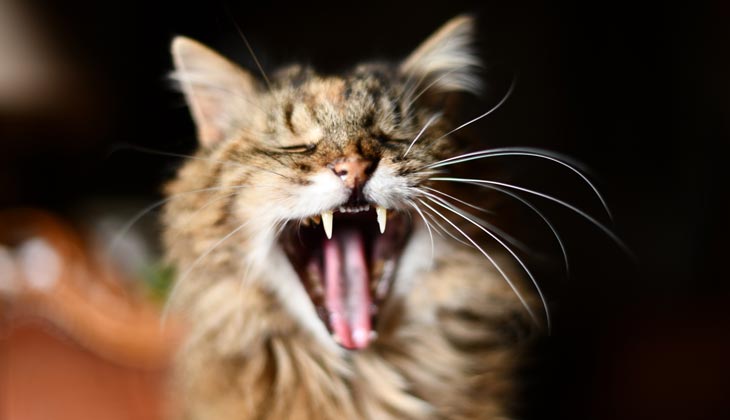It may surprise you that just as with us humans, teeth and gum problems are very common among our feline friends. Just like in humans, dental disease in cats can cause a considerable decrease in quality of life, if not kept in check.
Mouth problems are common in cats of all ages. This is generally associated with the accumulation of dental plaque (due to bacteria in the mouth) and dental tartar or calculus (plaque calcification). These issues can lead to “periodontal disease,” a condition affecting the structures that support and keep the teeth healthy, such as the gums, which can lead to tooth loss.

Gingivitis, from the Latin “gingiva,” for gums, and the suffix “itis,” for inflammation, is one of the symptoms of gum disease. Gingivitis is the earliest stage of periodontal disease. Gingivitis is usually associated with poor oral hygiene and is most commonly caused by bacterial infection due to plaque bacteria on the teeth that leads to inflammation of the gums.
Cats can also get gingivostomatitis, a more generalized inflammation of the oral tissues, including the gums, tongue, inner surfaces of the lips, and/or the floor and roof of the mouth. This disorder is relatively uncommon.
Several factors affect the development of disease, which include the following:
TOOTH ALIGNMENT
Correct tooth alignment is important and overcrowding or misalignment can lead to gingivitis or worse.
- Some breeds of cats are flat-nosed with short jawbones. These breeds include Persians, Chinchillas and British and Exotic shorthairs, to name a few. Their facial structure can mean that there can be overcrowding and/or misalignment of their teeth.
- If cats retain their baby or milk teeth (deciduous teeth), this can lead to misalignment of adult teeth.
- Injuries, such as a broken jaw may lead to tooth misalignment.
INFECTIOUS DISEASES
- Persistent feline calicivirus (FCV) infection may be associated with some cases of chronic (long-standing) gingivitis or gingivostomatitis.
- Feline immunodeficiency virus (FIV) infection and feline leukemia virus (FeLV) infection can cause immunosuppression and may predispose a cat to periodontal disease and gingivitis. Ask your veterinarian about screening your cat for these diseases.
FELINE RESORPTIVE LESIONS
Tooth erosion or feline resorptive lesions (FRL) are not uncommon in cats. The cause of FRL is unknown but cells which break down tooth substance, called odontoclasts, can be found in these lesions. These erosions are commonly formed around the gumline and may be covered by tartar but can also be found below the gum line in some cats. This means that these lesions often remain undetected or can coexist with gingivitis if there is reddening of the gums. Your veterinarian can assess the extent of the damage by taking X-rays of your cat’s teeth, under anaesthesia, and propose a treatment plan.

HOW DO I KNOW IF MY CAT HAS DENTAL DISEASE?
Gingivitis is manifested by typical signs of inflammation such as redness, pain and swelling. Frequently, a reddened gum-line forms around the teeth. Not all cats will let you look in their mouths, and if you’re unable to see inside your kitty’s mouth, signs of dental disease may also be apparent from the behaviour of your four-legged friend. Does your kitty still eat regularly and sufficiently? Cats with painful mouths may salivate more, tilt their head when eating and begin to smack or slurp. In effort to get rid of the pain, they often scratch their mouths with their paws. If eating becomes extremely painful, affected cats can start hissing at their food or run away after trying to eat. When cuddling, you might also notice that your cat suffers from bad breath. Cats will quite often not show clinical signs until the dental disease is advanced, by which time many teeth may need to be extracted.
HOW IS DENTAL DISEASE IN CATS TREATED?
As soon as you notice signs that might point to dental disease, you should have your cat examined thoroughly by a veterinarian. Your vet can remove tartar and plaque from your cat’s teeth under anaesthesia. A closer look can also be taken at all of your cat’s teeth and, any loose teeth removed. Since the cat bite is designed to tear meat and not chew, your kitty can live well with some teeth missing. Depending on the degree of inflammation, your veterinarian will also recommend follow-up treatment with medication. If your cat repeatedly has gingivitis or tartar, you should consider regular dental care.
WHAT DOES REGULAR DENTAL CARE FOR MY CAT ENTAIL?
For optimum dental care for your feline friend, you should let your veterinarian check your kitty for dental disease at least once every 12 months. Cats that have had dental problems should be examined more frequently. Generally, the sooner a problem is identified, the easier and quicker it can be treated.
You play an important role in keeping your cat’s mouth healthy. It is easiest to start with toothbrushing and other dental care when your cat is young – kittens can get used to this.
Your veterinarian can also advise you about treats, dental care products and special diets that may help to prevent plaque and tartar formation.
Home dental care can help to reduce plaque buildup and reduce the risk of gingivitis. Tartar cannot be removed by brushing the teeth. Ask your veterinarian about dental scaling to clean your cat’s teeth if there is tartar buildup.
In the same way you want to provide your feline companion with the care he or she needs to live a healthy life, paying attention to oral care is equally important to prevent dental disease.
Looking for a Vet?
Your veterinarian plays a big role in your pet’s health. Input your location information and get a list of veterinarians near you.
Find A Vet Near Me





 Go To United States
Go To United States Austria
Austria Belgium
Belgium Czech Republic
Czech Republic Denmark
Denmark Europe
Europe Finland
Finland France
France Germany
Germany Greece
Greece Hungary
Hungary Ireland
Ireland Israel
Israel Italy
Italy Netherlands
Netherlands Norway
Norway Poland
Poland Portugal
Portugal Romania
Romania Slovakia
Slovakia Spain
Spain Sweden
Sweden Turkey
Turkey United Kingdom
United Kingdom